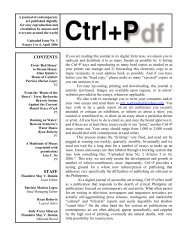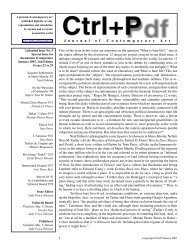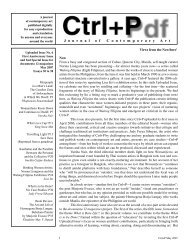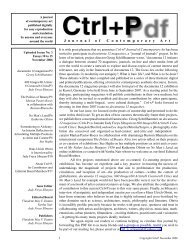Issue 15 - Pdf Ctrl+P - CTRL+P: a journal of contemporary art
Issue 15 - Pdf Ctrl+P - CTRL+P: a journal of contemporary art
Issue 15 - Pdf Ctrl+P - CTRL+P: a journal of contemporary art
Create successful ePaper yourself
Turn your PDF publications into a flip-book with our unique Google optimized e-Paper software.
Yuskavage. True Blonde (1999).<br />
Yuskavage. Imprint (2006)<br />
at different ages shown to us simultaneously? Perhaps this is why Yuskavage has begun<br />
painting two figures in some <strong>of</strong> her recent works such as Imprint (2006). As Yuskavage<br />
suggested to an interviewer: “I would put out the possibility that there are not two figures.<br />
That there is one figure, one entity. It’s the idea <strong>of</strong> caring for oneself or struggling<br />
with oneself” (Scott, 2006). Imprint is my favorite Yuskavage painting—so poetic in its<br />
representation <strong>of</strong> the two ages <strong>of</strong> a woman—the forty-something clinging to her youth<br />
which looks ambivalently on the older woman she is to become.<br />
The woman in True Blonde may appear, at first glance to be masturbating, but on<br />
second glance, she also appears rather introspective and her almost stereotypical (but as<br />
always in a Yuskavage), imperfect body is more like that <strong>of</strong> Day. Perhaps she is a magazine<br />
model—but one saddened by her occupation pondering other possibilities. Further,<br />
in most pornographic imagery she would appear in stockings and the black shadow line<br />
falling over her left thigh may indeed be Yuskavage’s way <strong>of</strong> entreating us to think about<br />
that. This might be a woman protecting her sexuality from the viewer, keeping one <strong>of</strong> her<br />
powers and her pleasures to herself. If this were an image in a pornographic magazine<br />
then it is quite likely that the woman’s sexual organs would be exposed and a much more<br />
explicit image <strong>of</strong> masturbation would be shown. In those images the woman typically<br />
looks into the camera with her air brushed misty eyes.<br />
There is also the title “True Blonde” which plays upon the old witticism that the<br />
only way to know the true colour <strong>of</strong> a woman’s hair is to see her pubic area. In this case,<br />
we are prevented from seeing this area by the sitter herself. For all we know this may be<br />
an image <strong>of</strong> a woman coming to contemplate her own powers, desires, fantasies. Maybe<br />
Yuskavage’s <strong>art</strong> is about the women—not the viewer!<br />
It seems that whatever her motivations and intentions, Lisa Yuskavage has managed<br />
to be understood as a sexist and a feminist at the same time, although the painter<br />
does not seem to identify her <strong>art</strong> with feminism: “There’s nothing more real than politics,<br />
and my work is not about what’s real,” she says (Scott, 2006). Eschewing politics for<br />
fiction, her work is likely to <strong>of</strong>fend the orthodox feminist as it is the stereotypical “old<br />
white male conservative.” This, to my mind, is among the best things about Yuskavage’s<br />
work. Like many <strong>art</strong>ists (be they writers, painters, photographers etc.), Yuskavage does<br />
not seek an empirical or a political resolution to the world in her <strong>art</strong>—but rather—a<br />
poetic one. Inviting multiple and complex readings, Yuskavage cultivates, intentionally<br />
or otherwise, uncertainty. The kind <strong>of</strong> pleasant uncertainty that stimulates debate and<br />
engagement with <strong>art</strong>. As Jean Baudrillard would understand the world is given to us as<br />
enigmatic and unintelligible—why cannot the task <strong>of</strong> thought (including poetry, fiction,<br />
painting) be to make the world even more enigmatic, more unintelligible? (2000:83; see<br />
also 1996:105; and 2001:<strong>15</strong>5)<br />
Conclusion<br />
Perhaps in our Patriot Act, post-September 11, 2001 world, the critics<br />
(especially those located in New York), prefer their <strong>art</strong> on the lighter side. I<br />
have a feeling that if a pre-Raphaelite were to emerge in New York s/he would<br />
be highly celebrated at this time. Painters react to the times in which they live.<br />
Yuskavage has her way, the escapists have theirs. Robert Rauschenberg worried<br />
that every new thing he learned about <strong>art</strong> placed a certain limit on him. This is<br />
true <strong>of</strong> everything we learn no matter how useful or valuable it may be. Much<br />
<strong>of</strong> the negative critical response to Lisa Yuskavage’s <strong>art</strong> reminds me <strong>of</strong> another<br />
woman <strong>art</strong>ist—Jenny Holtzer and one <strong>of</strong> her “Truisms”: “you are a victim <strong>of</strong><br />
the rules you live by.”<br />
One critic recently said (not supportively) that Yuskavage was a good example<br />
<strong>of</strong> the Andy Warhol quip: “Art is what you can get away with” (Naves,<br />
2003). The same may also be said about <strong>art</strong> criticism. In any event Yuskavage<br />
does not seem to be paying much attention to the critics and in her interview with<br />
Enright she also cited Warhol when asked how she felt about the critics. She said<br />
she hoped they spelled her name correctly and otherwise does not worry about<br />
what the critics are saying—simply measure it in press column inches (Enright,<br />
2007).<br />
26 <strong>Ctrl+P</strong> September 2009







